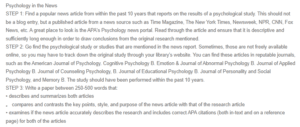Social Media and Adolescent Mental Health
Social media, which is a form of electronic communication, has swiftly evolved in the recent century. Undeniably, social media presents numerous benefits for people regardless of their age and location, as it is through social media websites like Facebook, Instagram, YouTube, etc, that people create content, share messages and information, network, and advertise their products and services. However, according to (the Office of the Assistant Secretary for Health (OASH), 2023), social media can have detrimental effects on people’s mental health, especially teens. Hence the question, “Is social media bad for teens?” This paper offers a comparative summary of two publications related to the impact of social media on adolescent mental health. The first article, a news piece by Claire Cain Miller, titled “Everyone Says Social Media Is Bad for Teens. Proving It Is Another Thing,” explores the potential consequences of social media use on teenagers’ well-being, while the second article, a research study conducted by Riehm et al., investigates the associations between time spent on social media and internalizing and externalizing problems among U.S. adolescents.
The news article by Claire Miller primarily focuses on the growing concern surrounding the effect of social media on teenagers’ mental health (Miller, 2023). It discusses key points, such as the ubiquity of social media among adolescents, the potential negative influences, and concerns related to issues like cyberbullying, unrealistic self-presentations, and the prevalence of depressive and anxiety symptoms. The primary purpose of this news article is to inform the general public about these concerns and encourage a conversation about responsible social media use.
On the other hand, the research study by Riehm et al. takes a more scientific and data-driven approach. It delves into the issue by examining a large sample of U.S. adolescents to determine if time spent on social media is prospectively linked to internalizing and externalizing problems. The research is meticulous, analyzing data from 6595 participants and considering various factors such as demographics, prior mental health problems, and substance use (Riehm et al., 2019).
Subsequently, the news article, which describes the research, is focused on raising awareness and prompting discussions regarding the potential impact of social media on teen mental health. The research article, on the other hand, seeks to establish a connection between social media use and specific mental health problems. Consistently, the news article employs a more accessible and reader-friendly style, intending to inform and spark conversations among a general audience. In contrast, the research article adopts a formal, data-driven approach aimed at providing scientific evidence. Lastly, the news article accurately describes the research, summarizing the key findings about the association between social media use and internalizing problems among adolescents. However, it simplifies complex statistical data for a broader audience.
In summation, while both the news article and research study address the potential relationship between social media and adolescent mental health, they differ in focus, style, and purpose. The news article serves as a valuable introduction for the general public to the research findings, while the research article provides a comprehensive analysis of the topic. Together, they offer insight into the pressing issue of social media’s influence on teen mental health, the need for responsible usage, and further research in this area.
References
Miller, C. C. (2023, June 17). Everyone says social media is bad for teens. Proving it is another thing. The New York Times. https://www.nytimes.com/2023/06/17/upshot/social-media-teen-mental-health.html
Riehm, K. E., Feder, K. A., Tormohlen, K. N., Crum, R. M., Young, A. S., Green, K. M., Pacek, L. R., La Flair, L. N., & Mojtabai, R. (2019). Associations between time spent using social media and internalizing and externalizing problems among U.S. youth. JAMA Psychiatry, 76(12), 1266. https://doi.org/10.1001/jamapsychiatry.2019.2325
Office of the Assistant Secretary for Health (OASH). (2023, May 23). Surgeon General issues new advisory about effects social media use has on Youth Mental Health. HHS.gov. https://www.hhs.gov/about/news/2023/05/23/surgeon-general-issues-new-advisory-about-effects-social-media-use-has-youth-mental-health.html
ORDER A PLAGIARISM-FREE PAPER HERE
We’ll write everything from scratch
Question

Social Media and Adolescent Mental Health
Psychology in the News
STEP 1: Find a popular news article from within the past 10 years that reports on the results of a psychological study. This should not be a blog entry, but a published article from a news source such as Time Magazine, The New York Times, Newsweek, NPR, CNN, Fox News, etc. A great place to look is the APA’s Psychology news portal. Read through the article and ensure that it is descriptive and sufficiently long enough in order to draw conclusions from the original research mentioned.
STEP 2: Go find the psychological study or studies that are mentioned in the news report. Sometimes, those are not freely available online, so you may have to track down the original study through your library’s website. You can find these articles in reputable journals, such as the American Journal of Psychology. Cognitive Psychology B. Emotion & Journal of Abnormal Psychology B. Journal of Applied Psychology B. Journal of Counseling Psychology, B. Journal of Educational Psychology B. Journal of Personality and Social Psychology, and Memory B. The study should have been performed within the past 10 years.
STEP 3: Write a paper between 250-500 words that:
• describes and summarizes both articles
。 compares and contrasts the key points, style, and purpose of the news article with that of the research article
• examines if the news article accurately describes the research and includes correct APA citations (both in-text and on a reference page) for both of the articles

